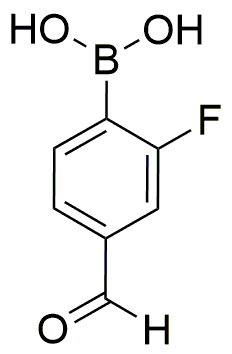2-Fluoro-4-formylphenylboronic acid is widely utilized in research focused on:
- Drug Development: This compound serves as a key intermediate in the synthesis of various pharmaceuticals, particularly in the development of anti-cancer agents. Its unique structure allows for the modification of drug properties, enhancing efficacy.
- Organic Synthesis: It plays a significant role in cross-coupling reactions, which are essential for creating complex organic molecules. This application is particularly valuable in the fields of materials science and organic electronics.
- Bioconjugation: The boronic acid functionality enables selective binding to diols, making it useful in bioconjugation techniques. This is crucial for creating targeted drug delivery systems and diagnostic tools.
- Fluorescent Probes: The compound can be utilized in the development of fluorescent probes for biological imaging. Its ability to form stable complexes enhances the sensitivity and specificity of imaging techniques.
- Environmental Chemistry: It is applied in the detection and removal of pollutants, particularly in water treatment processes. The compound’s reactivity allows for the capture of harmful substances, contributing to environmental protection efforts.
General Information
Properties
Safety and Regulations
Applications
2-Fluoro-4-formylphenylboronic acid is widely utilized in research focused on:
- Drug Development: This compound serves as a key intermediate in the synthesis of various pharmaceuticals, particularly in the development of anti-cancer agents. Its unique structure allows for the modification of drug properties, enhancing efficacy.
- Organic Synthesis: It plays a significant role in cross-coupling reactions, which are essential for creating complex organic molecules. This application is particularly valuable in the fields of materials science and organic electronics.
- Bioconjugation: The boronic acid functionality enables selective binding to diols, making it useful in bioconjugation techniques. This is crucial for creating targeted drug delivery systems and diagnostic tools.
- Fluorescent Probes: The compound can be utilized in the development of fluorescent probes for biological imaging. Its ability to form stable complexes enhances the sensitivity and specificity of imaging techniques.
- Environmental Chemistry: It is applied in the detection and removal of pollutants, particularly in water treatment processes. The compound’s reactivity allows for the capture of harmful substances, contributing to environmental protection efforts.
Documents
Safety Data Sheets (SDS)
The SDS provides comprehensive safety information on handling, storage, and disposal of the product.
Product Specification (PS)
The PS provides a comprehensive breakdown of the product’s properties, including chemical composition, physical state, purity, and storage requirements. It also details acceptable quality ranges and the product's intended applications.
Certificates of Analysis (COA)
Search for Certificates of Analysis (COA) by entering the products Lot Number. Lot and Batch Numbers can be found on a product’s label following the words ‘Lot’ or ‘Batch’.
*Catalog Number
*Lot Number
Certificates Of Origin (COO)
This COO confirms the country where the product was manufactured, and also details the materials and components used in it and whether it is derived from natural, synthetic, or other specific sources. This certificate may be required for customs, trade, and regulatory compliance.
*Catalog Number
*Lot Number
Safety Data Sheets (SDS)
The SDS provides comprehensive safety information on handling, storage, and disposal of the product.
DownloadProduct Specification (PS)
The PS provides a comprehensive breakdown of the product’s properties, including chemical composition, physical state, purity, and storage requirements. It also details acceptable quality ranges and the product's intended applications.
DownloadCertificates of Analysis (COA)
Search for Certificates of Analysis (COA) by entering the products Lot Number. Lot and Batch Numbers can be found on a product’s label following the words ‘Lot’ or ‘Batch’.
*Catalog Number
*Lot Number
Certificates Of Origin (COO)
This COO confirms the country where the product was manufactured, and also details the materials and components used in it and whether it is derived from natural, synthetic, or other specific sources. This certificate may be required for customs, trade, and regulatory compliance.


